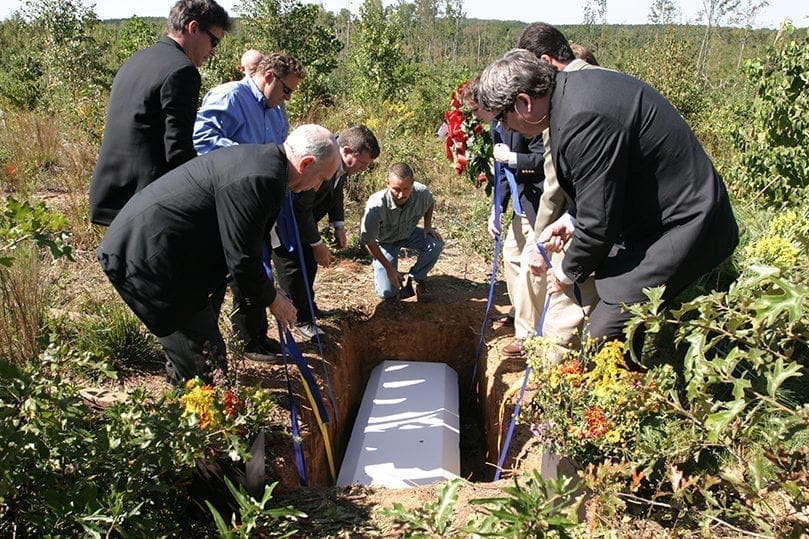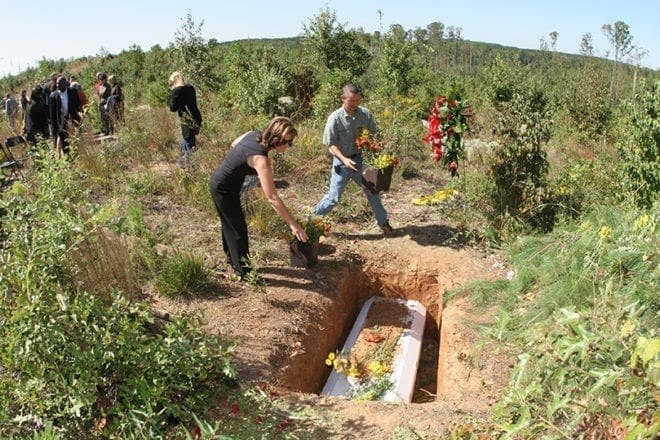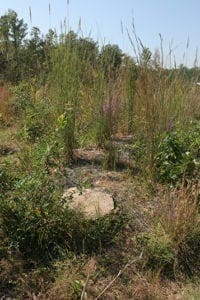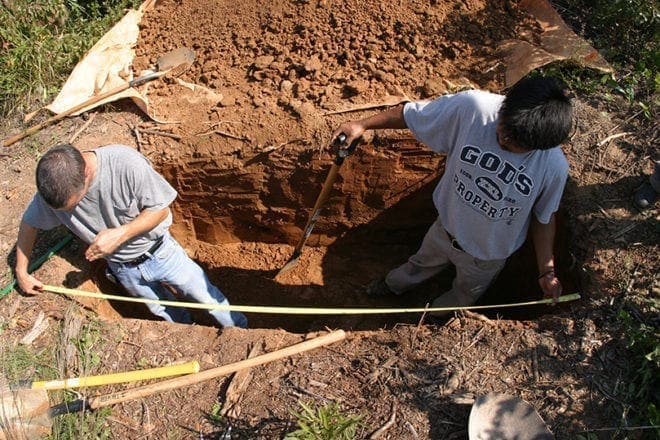 Photo By Michael Alexander
Photo By Michael Alexander
Conyers
New Cemetery Offers Eco-Friendly Option
By ANDREW NELSON, Staff Writer | Published November 6, 2008
Jack Jameson was the kind of guy who when a bum knee hobbled him took to lying down in the dirt to work in his beloved flower garden.
When the 81-year-old father of five died in his sleep, his family buried him where butterflies dance from flower to flower and the hum of crickets fills the air.
The day of his funeral in early October as he was put into the ground in a sturdy cardboard box filled his widow with dread. It ended with a smile.
“You could see the tension go out of her. She was so very, very happy about it,” said Elaine Bishoff, Jameson’s youngest daughter. “Everything about where he is makes us relaxed and happy. We miss him, and it’s still a big loss.”

A member of Jack Jameson’s family throws some flowers in his grave at the Honey Creek Woodlands Cemetery, Conyers, following the graveside prayer service, Oct. 1. Photo By Michael Alexander
The gravesite is a mile and a half into the woods, over a wooden bridge spanning Honey Creek in this “green cemetery,” where remains are put into the earth without embalming and only biodegradable caskets or urns are allowed. Some may choose to be buried in a shroud alone.
Since the funeral, Jameson’s widow, Gloria, has visited a few times. She’s gone on walks with his dog there and enjoyed a picnic.
“You don’t feel down. You don’t. It’s just different and it’s good,” said Gloria, 79, who retired after working at St. Pius X High School for 31 years.
Honey Creek Woodlands, about a mile off Highway 212, opened in the spring. The parcel of woodlands and pasture sits surrounded by some 2,000 protected acres owned by the Monastery of the Holy Spirit. It is a cemetery ground for people who want to be environmentally conscious when they die, and it preserves open land too. The cemetery is available to anyone who desires this style of burial.
The burial of the Army veteran started the day before when the cemetery manager, Joe Whittaker, and two laborers dug the grave. They carved out the red clay with a pickaxe and shovels. It took them close to four hours.
“It just doesn’t feel like a cemetery. It’s a living place. You hear the birds, the flowers,” said Whittaker. “It’s very much alive. It just puts people at ease. It’s not about death.”
The cemetery is a venture between the Cistercian monastery and a South Carolina company to convert clear-cut pinewoods into a “conservation burial ground.”
Simplifying Burial
Contemporary funeral traditions are relatively recent. Modern embalming techniques to preserve a body date to the Civil War, as mourning families wanted the remains of their loved ones brought home from distant battlefields.
Advocates for green funerals oppose the use of formaldehyde to preserve a body and other non-biodegradable aspects to burials, such as concrete vaults and metal caskets. They believe it wastes resources.
At this burial site, the family can be as involved as they would like, including digging the grave.
“It’s a family’s choice. We tell people there’s no formula here. There’s no script. We love to see family participate. It seems to help with the grieving and the healing. I’ve actually seen a smile on their face when they participate. It’s just feeling like you can do something,” said Whittaker.
“It’s nice to see family caring for their own,” he said.

A grave, which has settled over time, is displayed in the surroundings of its natural habitat. Photo By Michael Alexander
The practice of foregoing embalming and being buried in biodegradable containers was renewed in the 1990s in England. Since then, these types of cemeteries have spread in the United States. The Green Burial Council lists 10 cemeteries dedicated to green burials, as well as traditional funeral homes and regular cemeteries offering this as an option.
Honey Creek Woodlands is also protecting a significant natural area that is part of a much larger conservation effort, the Arabia Mountain Heritage Area. Within the monastery land holdings, the site is on the remains of a terraced farm area that likely grew cotton and other crops a century ago.
In many ways, the simple way people are buried at Honey Creek Woodlands resembles the burial rites of Orthodox Jews and Muslims, who are interred without embalming or an ornate casket. It also mirrors how the monks who own the land are buried in their simple shrouds.
Open To All
The green cemetery project is part of a wider initiative of the monastery. Currently, there is a $12 million capital campaign to strengthen the monastery’s finances and redevelop its industries so the community can be self-supporting again.
Abbot Francis Michael Stiteler said the cemetery is part of the monastery’s desire to preserve land and follows in the religious order’s commitment to be hospitable to all. “It’s certainly open to all faiths or no faiths. There’s something monastic to this. Our reception of guests will extend to even those who are dead,” he said.
It is not a Catholic cemetery, despite being owned by the monastery. The grounds have not been blessed. A priest can bless individual graves during a service, if that is desired.
Monks are not involved in the cemetery operations, and unless exceptions are made, monks are not allowed to attend the funerals.
“What we are offering is our land and the protection of that land,” the abbot said.
Catholics buried here will be prayed for by the monks, but not at the gravesite. The abbot is considering enrolling Catholics buried in the cemetery into the monastery’s perpetual prayer association, whose members are remembered every day at Mass.
Whittaker, who is 41, started in January as cemetery manager after working as a market researcher for the beverage industry. A native of Charleston, S.C., he works in a small office decorated with posters of dragonflies and butterflies. He uses a golf cart to move up the trail to the cemetery.
“I have not had one person come here, whether they were dealing with the death of a family (member) or they were terminally fighting a disease, that did not have a good day here,” he said.

Honey Creek Woodlands Cemetery manager Joe Whittaker, left, measures the grave as his helper Pedro looks on. Photo By Michael Alexander
The cemetery charges from $3,000 to $4,000 per plot, including a $100 restoration fee to plant native grasses and trees around the plot. A fieldstone can serve as a grave marker; the stone’s engraving can be done by monks.
The number of green burials is dwarfed by the number of people opting for a customary funeral, but interest in the option is growing. Some 21 percent of people over 50 are interested in eco-friendly funeral services, based on a 2007 poll by AARP. And according to the American Cemetery Magazine, 43 percent of Americans over 50 are interested in green burial.
The Green Burial Council, a New Mexico nonprofit, is seeing more funeral homes, casket manufacturers and others respond to the growing interest. Joe Sehee, the executive director, said people are responding to a desire to be environmentally conscious while being dissatisfied with contemporary funeral services. The council came up with standards for the certification of green cemeteries.
Ramsey Creek Preserve, in Westminster, S.C., was the first green cemetery opened in the United States in 1996. The founders are helping the monks’ green cemetery get established.
At Honey Creek Woodlands, there have been nearly 50 plots sold and a dozen interments since May, Whittaker said.
‘What I Can’t Believe About It Was How Good I Felt’
Bishoff and her husband had talked about how they wanted to be buried.
“Traditional burials just freaked me out. The unnaturalness of it, the metal casket, the embalming just kind of freaked me out,” she said.

Gulf fritillary butterflies occupy the pristine surroundings of Honey Creek Woodlands Cemetery, Conyers. The cemetery rests on some 70 acres of land owned by Holy Spirit Monastery. It has been designated as a “green cemetery” because the remains are entombed without embalming and only biodegradable caskets or urns are permitted. Photo By Michael Alexander
She heard about the green cemetery and started to explore the idea. She didn’t expect to rely on it so soon.
When her father died without leaving any instructions for his remains, she took her mother along with a handful of people to see Honey Creek Woodlands.
The place fit their desires. Gloria said she and her husband talked about cremation, but this setting seemed to fit better.
“What I can’t believe about it was how good I felt about it as opposed to a cemetery. It was almost uplifting,” she said. Gloria purchased a site for herself beside her husband.
Bishoff and her husband also have purchased plots there.
A memory of the day of the funeral for Gloria was an orange butterfly that moved from one daughter to another until it rested on her. And since then she’s returned to enjoy the beauty of the place.
“It exceeded my expectations,” she said.